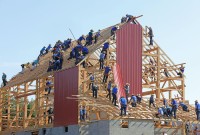- Home
- Business Processes
- Industry Knowledge
- Aerospace Industry
- Automotive Industry
- Banking Domain
- BFSI Industry
- Consumer/ FMCG Industry
- Chemicals Industry
- Engineering & Construction
- Energy Industry
- Education Domain
- Finance Domain
- Hospitality Domain
- Healthcare Industry
- Insurance Domain
- Retail Industry
- Travel and Tourism Domain
- Telecom Industry
- Leadership Skills
- eLearning
- Home
- Leadership Skills
- Leadership Theories
- Skills Approach to Leadership
Skills Approach to Leadership
The skills approach to leadership suggests that certain skills are important for effective leadership. Skills are what leaders can learn and develop, whereas traits are innate characteristics. The main skills needed for leadership, according to one such theory, are technical, human, and conceptual.
What is Leadership Skills Approach?
Another approach in the Leadership studies is the “Leadership Skills Approach”. In the previous articles we focused on the “Traits Approach to Leadership” which was based on the personality of the leader, this approach focuses on knowledge and abilities that the leader has. This theory assumes that a leader can learn and develop certain skills that can transform one into a successful leader. Like the earlier Trait Approach this approach also has leader centered perspective.
Skills suggest what leaders can achieve, learn and develop whereas traits suggest who they are based on their intrinsic characteristics which they gain by the virtue of birth. The skills approach suggests that the skills, knowledge, and abilities that are required for a leader to be successful can be acquired thorough training and development.
What are skills?
A skill is the learned capacity to carry out pre-determined results often with the minimum outlay of time, energy, or both. In other words the abilities that one possesses. The dictionary defines skills as “An ability and capacity acquired through deliberate, systematic, and sustained effort to smoothly and adaptively carryout complex activities or job functions involving ideas (cognitive skills), things (technical skills), and/or people (interpersonal skills).”
What is Competence?
Competence (or competency) is the ability of an individual to do a job properly. A competency is a set of defined behaviors that provide a structured guide enabling the identification, evaluation and development of the behaviors in individual employees. Competence indicates sufficiency of knowledge and skills that enable someone to act in a wide variety of situations. Because each level of responsibility has its own requirements, competence can occur in any period of a person's life or at any stage of his or her career.
Leadership as a Skill:
By leadership skills we refer to the essential skills needed for successful leadership. Skills are graded sequences of actions directed to a purpose. At the center of the development of all skills are acts that are absolutely necessary for the effective practice of that skill. Research over many years has shown that there are several key activities that are essential to effective interactions between managers, their staff and their organizations and these activities are generally referred to as Leadership Skills.
Different Types of Skill Approach to Leadership:
Researchers have studied leadership skills and abilities for a number of years and proposed various theories to understand the process of leadership. However, two models that standout in the skills approach to leadership is:
1. Model proposed by Robert Katz in 1955
2. Model proposed by Michael Mumford and colleagues in the year 2000
These models can be seen as complimentary to each other, since they offer different views on leadership from the skills point of view. We will explore these models in the next articles in this series.
Advantages of Skills Approach to Leadership:
The practical and theoretical implications of regarding leadership as something that is constituted of some human skills that can be learned and developed are considerable. All skills have at their core components that are essential for their performance, and once a manager acquires required competencies in these areas they will become effective leaders too.
The biggest advantage of this approach is the assumption that leadership is not just by birth, that some people born with specific traits can only be effective leaders. This approach implies that many people have leadership potential, and if they get the requisite training, can focus on development of certain skills and can learn from their experiences, they can become more effective leaders.
This means that trainings can be designed involving activities and/or exposure to leadership circumstances and events that can lead to increase in skills, knowledge, and abilities.
Personality certainly plays an important role in leadership; this approach identifies and defines certain knowledge areas and abilities that are essential for effective leadership. Use of this approach has resulted in a comprehensive skill-based model of leadership that is used widely by organizations all over the world for advancement of leadership skills of their employees.
Skills Management:
This approach resulted in the concept of “Skills Management” which is the practice of understanding, developing and deploying people and their skills. Well-implemented skills management identifies the skills that job roles require, the skills of individual employees, and any gap between the two. Firstly the skills involved are defined in terms of a skills framework, also known as a competency framework or skills matrix. This consists of a list of skills, and a grading system, with a definition of what it means to be at particular level for a given skill. Then individuals assess and update their recorded skill sets regularly which provides a structured approach to developing individual and collective skills, and gives a common vocabulary for discussing skills.
Related Links
You May Also Like
-
All the teams are dynamic in nature and they take time to come together, they form, develop, and grow in stages, over a period of time. Teams go through five progressive stages: Forming, Storming, Norming, Performing and Adjourning. In this article, we want to introduce you to these stages of team development and certain strategies that you can use to help the team grow and develop in each of these stages.
-
Management theories are the recommended management strategies that enable us to better understand and approach management. Many management frameworks and guidelines were developed during the last four decades.
-
There are four major factors in leadership called Leader, Follower, Communication, and Situation. The success of the leader is dependent on how the leader is effectively able to communicate and motivate followers to perform desired tasks using the appropriate leadership style best suited for the given situation. Interdependencies and dynamics of these four factors of leadership must be considered by a leader to be effective.
-
Charismatic leadership is a trait-based leadership theory where the leaders act as visionary driven by their convictions and motivate their followers to work towards common vision using their charm and persuasiveness. These charismatic leaders act as role models and exhibit extraordinary characteristics that inspire devotion and motivation in followers to persuade change. Leaders are able to cultivate a profound sense of trust with the group of followers.
-
The style approach emphasizes that one style of leadership behaviour cannot be effective in all situations. Earlier theories treated leadership exclusively as a personality trait and behavior approach has widened the scope by including the behaviors of leaders and what they do in various situations. Explore how you can benefit from the concepts to understand your own behaviors and what are some of the leadership tools based on the style approach to leadership.
-
Leadership has been defined in different ways by different sets of scholars. In very simple terms leadership can be defined as the skill of a person to influence an individual or a group for achievement of a goal in a given situation. One can use different dimensions and perspectives to define leadership. Through the evolution of leadership thought, leadership has been defined in various ways discussed here.
-
Theory Z also called the "Japanese Management" style is a leadership theory of human motivation focused on organizational behavior, communication, and development. It assumes that employees want to enter into long term partnerships with their employers and peers. Offering stable jobs with an associated focus on the well-being of employees results in increased employee loyalty to the company.
-
Have you ever resonated that there seem to be as many different ways to lead people as there have been great leaders? When we recall the success of Mahatma Gandhi, Nelson Mandela, Abraham Lincoln, Napoleon Bonaparte to Steve Jobs and Jack Welch, we also notice that they all used different approaches that were suitable to their specific situations and circumstances. Over the last century, researchers and psychologists have developed simple ways to describe the “Styles of leadership” and in this section, we will explore these commonly known leadership styles.
-
Behavioral Theories of Leadership
Behavioral Theory of leadership is a big leap from Trait Theory, as it was developed scientifically by conducting behaviour focused studies. The theory emphasizes that leadership capability can be learned, rather than being inherent. This theory is based on the principle that a leader's behaviors can be conditioned in a manner that one can have a specific response to specific stimuli.
-
Life cycle theory of Leadership
Situational Leadership Theory was first introduced in 1969 as the life cycle theory of leadership. This theory suggests that type of leadership style appropriate in a given situation depends on the maturity of the follower. As per life cycle theory, leader need to match the leadership style according to the situation and leader behavior varies as the group matures.
Explore Our Free Training Articles or
Sign Up to Start With Our eLearning Courses

About Us
Learning
© 2023 TechnoFunc, All Rights Reserved










